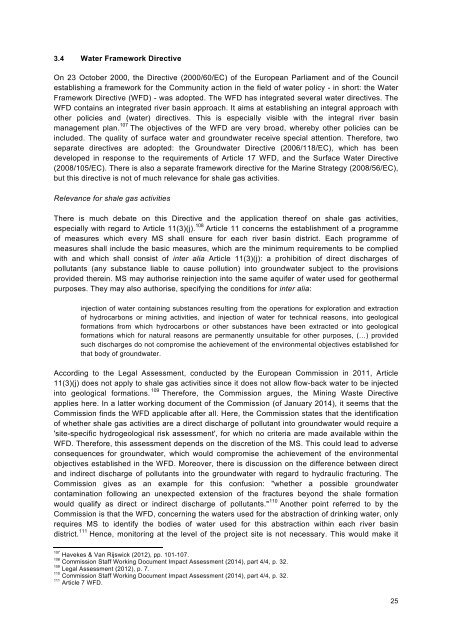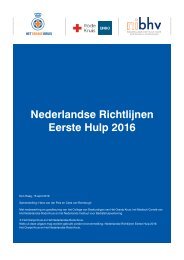Thesis-Anne-Vos-Masters-SBR-and-EU-Law-3
Thesis-Anne-Vos-Masters-SBR-and-EU-Law-3
Thesis-Anne-Vos-Masters-SBR-and-EU-Law-3
You also want an ePaper? Increase the reach of your titles
YUMPU automatically turns print PDFs into web optimized ePapers that Google loves.
3.4 Water Framework Directive<br />
On 23 October 2000, the Directive (2000/60/EC) of the European Parliament <strong>and</strong> of the Council<br />
establishing a framework for the Community action in the field of water policy - in short: the Water<br />
Framework Directive (WFD) - was adopted. The WFD has integrated several water directives. The<br />
WFD contains an integrated river basin approach. It aims at establishing an integral approach with<br />
other policies <strong>and</strong> (water) directives. This is especially visible with the integral river basin<br />
management plan. 107 The objectives of the WFD are very broad, whereby other policies can be<br />
included. The quality of surface water <strong>and</strong> groundwater receive special attention. Therefore, two<br />
separate directives are adopted: the Groundwater Directive (2006/118/EC), which has been<br />
developed in response to the requirements of Article 17 WFD, <strong>and</strong> the Surface Water Directive<br />
(2008/105/EC). There is also a separate framework directive for the Marine Strategy (2008/56/EC),<br />
but this directive is not of much relevance for shale gas activities.<br />
Relevance for shale gas activities<br />
There is much debate on this Directive <strong>and</strong> the application thereof on shale gas activities,<br />
especially with regard to Article 11(3)(j). 108 Article 11 concerns the establishment of a programme<br />
of measures which every MS shall ensure for each river basin district. Each programme of<br />
measures shall include the basic measures, which are the minimum requirements to be complied<br />
with <strong>and</strong> which shall consist of inter alia Article 11(3)(j): a prohibition of direct discharges of<br />
pollutants (any substance liable to cause pollution) into groundwater subject to the provisions<br />
provided therein. MS may authorise reinjection into the same aquifer of water used for geothermal<br />
purposes. They may also authorise, specifying the conditions for inter alia:<br />
injection of water containing substances resulting from the operations for exploration <strong>and</strong> extraction<br />
of hydrocarbons or mining activities, <strong>and</strong> injection of water for technical reasons, into geological<br />
formations from which hydrocarbons or other substances have been extracted or into geological<br />
formations which for natural reasons are permanently unsuitable for other purposes, (…) provided<br />
such discharges do not compromise the achievement of the environmental objectives established for<br />
that body of groundwater.<br />
According to the Legal Assessment, conducted by the European Commission in 2011, Article<br />
11(3)(j) does not apply to shale gas activities since it does not allow flow-back water to be injected<br />
into geological formations. 109 Therefore, the Commission argues, the Mining Waste Directive<br />
applies here. In a latter working document of the Commission (of January 2014), it seems that the<br />
Commission finds the WFD applicable after all. Here, the Commission states that the identification<br />
of whether shale gas activities are a direct discharge of pollutant into groundwater would require a<br />
'site-specific hydrogeological risk assessment', for which no criteria are made available within the<br />
WFD. Therefore, this assessment depends on the discretion of the MS. This could lead to adverse<br />
consequences for groundwater, which would compromise the achievement of the environmental<br />
objectives established in the WFD. Moreover, there is discussion on the difference between direct<br />
<strong>and</strong> indirect discharge of pollutants into the groundwater with regard to hydraulic fracturing. The<br />
Commission gives as an example for this confusion: "whether a possible groundwater<br />
contamination following an unexpected extension of the fractures beyond the shale formation<br />
would qualify as direct or indirect discharge of pollutants." 110 Another point referred to by the<br />
Commission is that the WFD, concerning the waters used for the abstraction of drinking water, only<br />
requires MS to identify the bodies of water used for this abstraction within each river basin<br />
district. 111 Hence, monitoring at the level of the project site is not necessary. This would make it<br />
107<br />
Havekes & Van Rijswick (2012), pp. 101-107.<br />
108<br />
Commission Staff Working Document Impact Assessment (2014), part 4/4, p. 32.<br />
109<br />
Legal Assessment (2012), p. 7.<br />
110<br />
Commission Staff Working Document Impact Assessment (2014), part 4/4, p. 32.<br />
111<br />
Article 7 WFD.<br />
25



